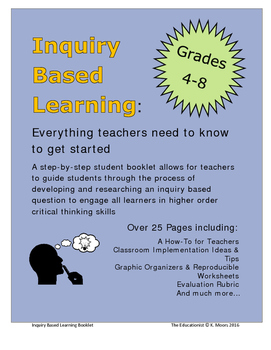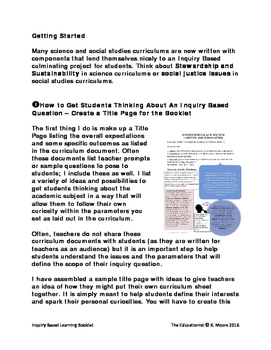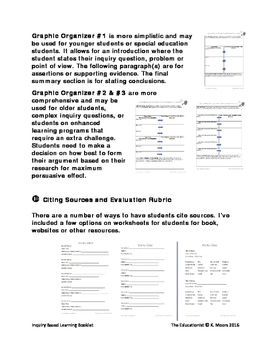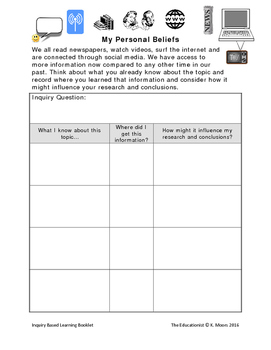Inquiry Based Learning Project: Step-by-Step Student Booklet
The Educationist
77 Followers
Grade Levels
4th - 8th, Homeschool
Standards
CCSSW.4.1
CCSSW.4.5
CCSSW.4.7
CCSSW.4.8
CCSSW.4.10
Formats Included
- PDF
Pages
31 pages
The Educationist
77 Followers
Description
Inquiry Based Learning: Everything teachers need to know to get started includes over 25 pages. A step-by-step student booklet allows for teachers to guide students through the process of developing and researching an inquiry based question to engage all learners in higher order critical thinking skills.
A How-To for Teachers
Inquiry based learning is a pedagogical approach to learning that is gaining momentum in mainstream education in many countries. It is not a new approach but rather a more student-centered approach to learning when compared to the more traditional teacher-focused classrooms we are familiar with.
Teacher reluctance to engage in Inquiry Based Learning stems from a perceived inability to effectively guide a classroom full of students at varying levels and abilities with individual unique questions and personalized feedback. That was my feeling when I first began. I felt that it was an impossible task.
Think of Inquiry Based Learning as a process rather than a restricted set of content based grade leveled curriculum expectations or outcomes. When you teach and guide students through the process, they access the mandated curriculum content in a way that goes far beyond the simple memorization and regurgitation of content.
You will see how even your lowest students will move up the cognitive domains as outlined in Bloom’s Taxonomy (1956): knowledge, comprehension, application, analysis, synthesis and evaluation. Anderson and Krathwohl revised this in 2001 to: remembering, understanding, applying, analyzing, evaluating and creating.
When we look at Inquiry based learning in its simplest form, we can see the steps required for students to move through the process students:
1. Formulate their own research question
2. Decide how to conduct research
3. Communicate their findings, conclusions and/or results
These steps seem simple enough but they require a significant amount of discussion between teachers and students and students and students in order for students to be able to think critically and refine their questioning and understanding of a chosen topic.
How does a teacher document these conversations, observations and developments in students’ thinking and understanding with 25 students in a class? The simple answer is; you don’t. You have students document their own learning.
How It Works
Each step of the Inquiry based learning process is documented on a worksheet that makes it easy for both students and teachers. Teachers are able to guide students through the worksheets and provide personalized feedback at a glance. This is a quick and easy step to document what you do and say to students. It is then easy to follow up and see if students take that feedback and teacher’s suggestions to improve their work.
Teacher Tip: Personalized feedback is an ever increasing component of effective teaching that both parents and principals/administrators look for. Often times it is hard to document but I suggest you use a brightly colored ink pen to provide this feedback to students. It is easy for students to see and refer to and you have a quick record of your discussion and recommendations to students.
How to Get Students Thinking About An Inquiry Based Question – Create a Title Page for the Booklet
NOTE TO TEACHERS: You will have to create your own Title Page based on your curriculum documents. This is not provided due to the uniqueness of curriculum documents by country, state/province, and/or grade level.
The first thing I do is make up a Title Page listing the overall expectations and some specific outcomes as listed in the curriculum document. I explain how to do this to support student development and refinement of an inquiry question. A criteria checklist is included to guide students on how to create a deep inquiry question.
Worksheets are included to help students understand their own beliefs and biases, and guide them to use appropriate sources and force them to consider their sources critically and carefully. A graphic organizer is included to help students organize research and critically assess each source.
Suggestions are provided for a final product be it an expository essay, letter, speech or presentation. A variety of graphic organizers are provided to aid students in this task depending on the student’s ability, nature of the topic and research conducted.
Worksheets are included for citing sources. A final evaluation rubric for Inquiry Based Learning is also included.
Inquiry based learning takes a little extra effort in the beginning to introduce students to the process. This handy Inquiry Based Learning Booklet lays out the process in an easy to follow format that scaffolds the learning for students while introducing them to the necessary steps and vocabulary that is essential for a successful inquiry that supports students’ ability to think critically.
Happy Teaching,
The Educationist
Check my store often as I am adding new items all the time.
A How-To for Teachers
Inquiry based learning is a pedagogical approach to learning that is gaining momentum in mainstream education in many countries. It is not a new approach but rather a more student-centered approach to learning when compared to the more traditional teacher-focused classrooms we are familiar with.
Teacher reluctance to engage in Inquiry Based Learning stems from a perceived inability to effectively guide a classroom full of students at varying levels and abilities with individual unique questions and personalized feedback. That was my feeling when I first began. I felt that it was an impossible task.
Think of Inquiry Based Learning as a process rather than a restricted set of content based grade leveled curriculum expectations or outcomes. When you teach and guide students through the process, they access the mandated curriculum content in a way that goes far beyond the simple memorization and regurgitation of content.
You will see how even your lowest students will move up the cognitive domains as outlined in Bloom’s Taxonomy (1956): knowledge, comprehension, application, analysis, synthesis and evaluation. Anderson and Krathwohl revised this in 2001 to: remembering, understanding, applying, analyzing, evaluating and creating.
When we look at Inquiry based learning in its simplest form, we can see the steps required for students to move through the process students:
1. Formulate their own research question
2. Decide how to conduct research
3. Communicate their findings, conclusions and/or results
These steps seem simple enough but they require a significant amount of discussion between teachers and students and students and students in order for students to be able to think critically and refine their questioning and understanding of a chosen topic.
How does a teacher document these conversations, observations and developments in students’ thinking and understanding with 25 students in a class? The simple answer is; you don’t. You have students document their own learning.
How It Works
Each step of the Inquiry based learning process is documented on a worksheet that makes it easy for both students and teachers. Teachers are able to guide students through the worksheets and provide personalized feedback at a glance. This is a quick and easy step to document what you do and say to students. It is then easy to follow up and see if students take that feedback and teacher’s suggestions to improve their work.
Teacher Tip: Personalized feedback is an ever increasing component of effective teaching that both parents and principals/administrators look for. Often times it is hard to document but I suggest you use a brightly colored ink pen to provide this feedback to students. It is easy for students to see and refer to and you have a quick record of your discussion and recommendations to students.
How to Get Students Thinking About An Inquiry Based Question – Create a Title Page for the Booklet
NOTE TO TEACHERS: You will have to create your own Title Page based on your curriculum documents. This is not provided due to the uniqueness of curriculum documents by country, state/province, and/or grade level.
The first thing I do is make up a Title Page listing the overall expectations and some specific outcomes as listed in the curriculum document. I explain how to do this to support student development and refinement of an inquiry question. A criteria checklist is included to guide students on how to create a deep inquiry question.
Worksheets are included to help students understand their own beliefs and biases, and guide them to use appropriate sources and force them to consider their sources critically and carefully. A graphic organizer is included to help students organize research and critically assess each source.
Suggestions are provided for a final product be it an expository essay, letter, speech or presentation. A variety of graphic organizers are provided to aid students in this task depending on the student’s ability, nature of the topic and research conducted.
Worksheets are included for citing sources. A final evaluation rubric for Inquiry Based Learning is also included.
Inquiry based learning takes a little extra effort in the beginning to introduce students to the process. This handy Inquiry Based Learning Booklet lays out the process in an easy to follow format that scaffolds the learning for students while introducing them to the necessary steps and vocabulary that is essential for a successful inquiry that supports students’ ability to think critically.
Happy Teaching,
The Educationist
Check my store often as I am adding new items all the time.
Total Pages
31 pages
Answer Key
Rubric only
Teaching Duration
1 month
Report this resource to TPT
Reported resources will be reviewed by our team. Report this resource to let us know if this resource violates TPT’s content guidelines.
Standards
to see state-specific standards (only available in the US).
CCSSW.4.1
Write opinion pieces on topics or texts, supporting a point of view with reasons and information.
CCSSW.4.5
With guidance and support from peers and adults, develop and strengthen writing as needed by planning, revising, and editing.
CCSSW.4.7
Conduct short research projects that build knowledge through investigation of different aspects of a topic.
CCSSW.4.8
Recall relevant information from experiences or gather relevant information from print and digital sources; take notes and categorize information, and provide a list of sources.
CCSSW.4.10
Write routinely over extended time frames (time for research, reflection, and revision) and shorter time frames (a single sitting or a day or two) for a range of discipline-specific tasks, purposes, and audiences.





